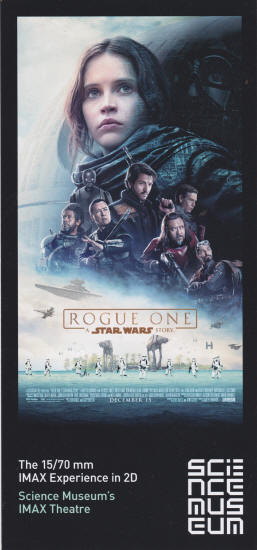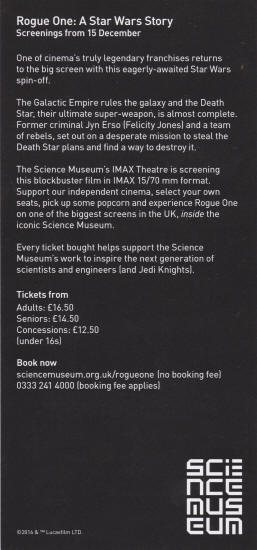The Dunkirk 70mm Imax preview, plus the support film, Star Wars Rogue One |
Read more at in70mm.com The 70mm Newsletter |
| Written by: Paul Sutton | Date: 24.12.2016 |
 In keeping with the bizarre British practise, the Science Museum now requires
patrons to choose their Imax seat at the time of booking online, which means
that all the good seats sell out the moment they go on sale. Such a daft
practise also stops you from arranging to meet up with friends and renders many
of the seats unsaleable, i.e the front rows and the end of aisles, hitherto the
just desserts for late arrivals. In keeping with the bizarre British practise, the Science Museum now requires
patrons to choose their Imax seat at the time of booking online, which means
that all the good seats sell out the moment they go on sale. Such a daft
practise also stops you from arranging to meet up with friends and renders many
of the seats unsaleable, i.e the front rows and the end of aisles, hitherto the
just desserts for late arrivals. Last year, when I told a friend I was going to the Imax cinema in the London Science Museum on such a day at such a time, he decided to bring his family along and meet up, and we were all able to arrive early, choose good seats when we got inside the auditorium and sit together. No such luck this year. The day the tickets went on sale, I scrolled through and found that the ‘good’ and premimum priced tickets had mostly sold in a flash. I found a single good seat for the 4.10pm screening on the first Monday of the Star Wars release and so had to go by myself. Of course, the cinema was almost half empty. No one wanted to pay huge prices to sit in the front rows or on the sides and no one had the option of arranging to meet up and sit with friends. Then the show began. There were a lot of adverts. By a lot I mean there were, for example, SEVEN adverts for cars, and others for X-box and all kinds of things I’m not interested in. If you are going to take up my time by forcing me to sit through commercials then don’t charge me or anyone for the ticket. Then the main film began - six minutes of Christopher Nolan’s "Dunkirk" - and it was really rather thrilling, except that the large latticed metal barrier in front of the front row obscured a lot of the bottom part of the screen from my view from the top price seat in the very middle of row G. From this I learned that if you want an unrestricted view you have to pre-choose a seat higher up than row G. This rule applies only to films filmed and screened in the imax format (which is higher than it is wide). Like "Intersteller", Nolan's "Dunkirk" shape-shifted as it moved from scenes shot in Imax to a brief shot of a scene shot in 65mm (and therefore wider than tall and not partially obscured by the metal barrier). The presentation of the "Dunkirk" footage reminded me of the super 8mm edits of feature films one used to enjoy back in the day - a collage of show scenes with just enough exposition (about 10 lines of dialogue) to get the story across. Much of the footage was of an aerial dogfight, fabulously filmed from within and without the cockpit, and of hordes of properly pale-looking young Englishmen in uniform carrying stretchers, huddled in boats, and looking very apprehensive as the sound of bombers zero in on them and scream all around us. The soundtrack is truly monumental and terrifying and immersive. The production design looks right to the last stitch, the scale is a wonder to behold, and this must be the most authentic recreation of large-scale war scenes on film, except for one howler. Nolan doesn’t attempt to get the colours right. Instead of using the colours of the day and of nature, he has plumped for the cliché of destaturation to leave us with nothing much more than a weak and watery blue. Doubtless, if I live long enough, I’ll be able to see the film in every real cineaste’s favourite mono-colour - Bradford pink. |
More in 70mm reading: Oslo 70mm Film Festival Cinerama Festival - Seattle October 2011 Rogue One: A Star Wars Story - The IMAX Experience Internet link: |
 After the mainshow, the supporting feature was this year’s Star Wars film.
I didn’t like last year’s Star Wars film at all, but
I stayed and watched this year’s Star Wars and I loved it. Early on,
I grudgingly admitted to myself that I liked the designs.
I liked the realism of the rust on the undersides of metals, and the dirt and
the dust on the stormtroopers uniforms. I loved the tapestry of details from the
child’s stormtrooper doll to the integrated monsters and machines. I was
grinning from ear to ear during the richly detailed deep-focussed space battles.
The writing was better than serviceable and some of the dialogue was good. As a
film it was ambitious and dark. Surprisingly dark. For comedy relief there is a
bad CGI cameo of Princess Leia, and bad CGI scenes of the little boy from "The
Polar Express" now all grown up and playing Grand Moff Tarkin (why hasn’t
CGI improved since 2004?). After the mainshow, the supporting feature was this year’s Star Wars film.
I didn’t like last year’s Star Wars film at all, but
I stayed and watched this year’s Star Wars and I loved it. Early on,
I grudgingly admitted to myself that I liked the designs.
I liked the realism of the rust on the undersides of metals, and the dirt and
the dust on the stormtroopers uniforms. I loved the tapestry of details from the
child’s stormtrooper doll to the integrated monsters and machines. I was
grinning from ear to ear during the richly detailed deep-focussed space battles.
The writing was better than serviceable and some of the dialogue was good. As a
film it was ambitious and dark. Surprisingly dark. For comedy relief there is a
bad CGI cameo of Princess Leia, and bad CGI scenes of the little boy from "The
Polar Express" now all grown up and playing Grand Moff Tarkin (why hasn’t
CGI improved since 2004?). The print was immaculate, of course, brand-new, but I was surprised that the dark scenes lacked contrast, particularly in the first reel. The black scenes lacked black. It was a muddy brown print, a fault, I presume, of the processing and manufacture? or the problem with shooting in digital and blowing it up and printing it on film? There was depth but there wasn’t a true Imax or 70mm immersion (except in the computer-generated outer space scenes). I think that part of the problem was the editing. I was not at all surprised to see the credit ‘additional editing by Stuart Baird’. Baird’s first film as editor was Ken Russell’s glorious rock opera, "Tommy". Thereafter Baird imported Russell’s psychedelic high style into Hollywood action pictures but without carrying over Russell’s understanding of pacing and drama. The Baird style has long been the Hollywood action style, all flash and dash and no substance, blazes of images without geometry or geography, and without a satisfying sense of pace and this clashed with the director Gareth Edwards’s strong sense of space and place. The Baird editing style allows us to glimpse, it doesn’t let us see. 70mm film is for seeing. |
|
| Go: back - top - back issues - news index Updated 22-01-25 |
